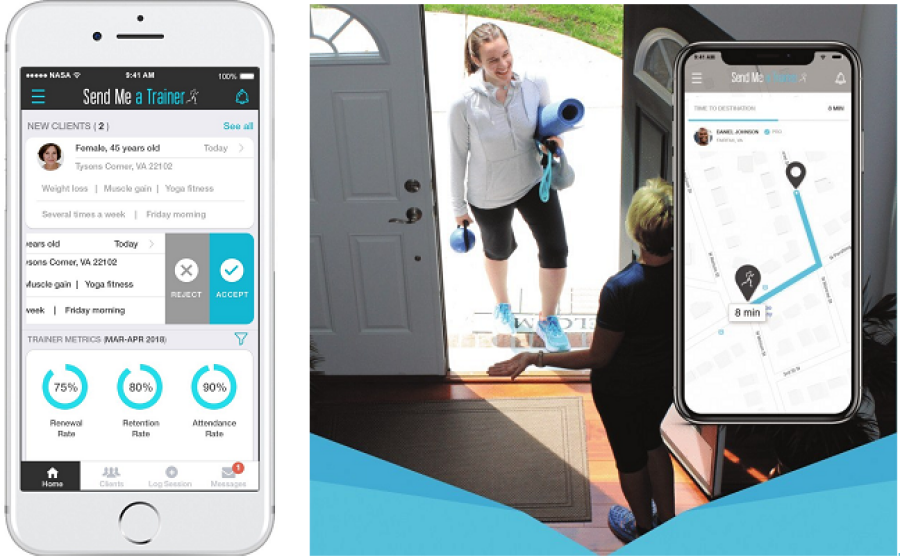🕒 Estimated Reading Time: ~8 minutes

If you’re good at developing relationships and passionate about helping people get and stay in shape, the fitness franchise industry could be a match for you.
The Canadian Gym, Health and Fitness Clubs industry is on the rebound following a blip in its growth trajectory caused by the COVID-19 pandemic. According to IBISWorld, it’s a $4.7 billion market that is expected to increase 7.1% in 2022, following annual growth of 2.4% on average between 2017 and 2022.
From the company’s report, “Moving forward, the Gym, Health and Fitness Clubs industry in Canada is expected to continue growing, benefiting from rising health consciousness and a diversification of services to fuel consumer growth.”
And it’s the diversification of services that we’ll focus on for much of this report.
The Diversity of Fitness Franchise Options
Advancements in technology and data collection have led to more specialized ways to deliver fitness services to people, which means people can utilize fitness services in a way that is best for them individually. As a result, there is no shortage of areas a prospective franchisee can get into when picking a fitness franchise to own. Some examples are described below.
One way fitness franchises have decided to specialize their services around is a highly-developed and specialized methodology.
An example of a franchise doing this is Orangetheory Fitness. Its program is inspired by the scientific phenomena of Excess Postexercise Oxygen Consumption (EPOC), the body’s elevated demand for oxygen and prolonged calorie-burning functions that continue even after cardiovascular exercise or weight training has finished.
Segmentation from data gathered also allows for programs to be tailored to certain demographic groups.
The biggest demographic subset targeted is probably kids. Recent budget cutbacks have not only affected the academic side of education; physical fitness programs also have taken a hit. Also, parents have increasingly discovered the benefits to getting kids active early.

My Gym, for example, is one of these fitness franchises that uses an integrated methodology to encourage healthy habits in kids. The franchise system focuses on helping children as young as 6 weeks thru the age of 10 years “develop physically, cognitively and emotionally.”
Safety is also a selling point for kid-oriented fitness franchises. An example of this are swim school franchises like Aquastream, British Swim School and Goldfish Swim School, which focus on teaching water survival techniques for infants and children.
The original segmentation subset, however, surrounds what is taught in the class.
It’s been happening for decades. For instance, YogaFit was developed in the 1990s to address the challenges of teaching yoga – then a trend, not yet a mainstay – in modern health clubs. The goal was to develop a more “user-friendly” style that combined fitness moves such as push-ups, sit-ups and squats with traditional yoga postures in order to appeal to, and ultimately gain, more clients. Similar can be said for Pilates.
One of the hottest areas currently in fitness franchising is MMA (Mixed Martial Arts). Common disciplines of MMA include: boxing, Muay Thai, kickboxing, jiu-jitsu, judo, wrestling, karate, and taekwondo.
The aim for many of these franchises is to integrate core martial arts principles and philosophies into mainstream fitness culture to fight the boredom of a “typical” workout. Examples include: UFC Gym, 9Round, Rumble Boxing, Action Karate, Premier Martial Arts, and TITLE Boxing Club.
And for those who desire something more extreme, the bootcamp has become all the rage. Franchises such as Basecamp Fitness, Fit Body Boot Camp, and others offer intense sessions to their clientele.
And customization doesn’t just stop with the fitness style or who the workout is catered to.
Franchisors are also catering their sites to the communities where their franchisees open a location. For instance, as Fitness 1440 General Manger Michael Wilson said, “Our gyms aren’t cookie-cutter images of each other but, instead, vary in size and capabilities depending on the community they serve.”
This means you could get one that is a more typical strip-mall location, or you could end up with a fitness studio that is just under 30,000 feet and has personal training, a cinema room, massage beds, a kid’s club, saunas, and more.
But don’t think that because more contemporary methods of exercise are gaining followers, the more traditional gym workout is dying out. As the saying goes, “classics never go out of style.”
Classes that combine functional movement and cardio like treadmill running, cycling, and rowing are expected to trend upward. In fact, relatively new entrants to the franchise world – such as CycleBar, SPENGA, STRIDE, Row House, and more – are proof that that traditional ways of working out will always be around.

Hybrid Fitness Franchise Models Gaining Steam
The COVID-19 pandemic caused immediate challenges for businesses across every sector, when it hit back in 2020. However, the fitness industry has had to adapt even more than most.
Now, over two years since the onset of the pandemic, the way the world exercises has officially changed and, as a result, so has the way fitness franchises operate, generally speaking.
Home workouts have always been popular. However, when social distancing became necessary, a way to operate away from the traditional studio or gym became necessary. Enter the hybrid fitness model.
As Julie Cartwright, president of P.volve, told Global Franchise Magazine, “With a hybrid fitness model, franchisors and franchisees can tap into both facets of this post-pandemic demand and ensure clients are able to achieve their personal health goals regardless of where they want to work out.”
Ideally, the concept allows franchises to build a best of both worlds following. With a hybrid approach, franchisors build out a traditional studio experience while concurrently developing an on-demand platform that customers can access whenever and wherever they want to work out.
And it’s no surprise hybrid is becoming popular. Convenience was becoming all the rage no matter what industry you operated in; the pandemic accelerated that consumer desire. “People want to work out in a way that’s convenient to them – they don’t always have time to commute, nor do they want to,” says Cartwright.
But some franchises are going to the extreme: No dedicated physical space at all.

Unsurprisingly, Send Me A Trainer saw a surge in business when the pandemic hit. Founded in 2007 by brothers Muhssin and Bary El-Yacoubi, the company curates a mobile app offering on-demand virtual and in-home personal training. “Home fitness was already popular in recent years and COVID-19 has only accelerated this trend and it is here to stay,” says El-Yacoubi.
And it’s an option that Canadians want. Even before the pandemic, nearly 80% of Canadians say it’s more convenient to exercise in the comfort of their own home rather than going to a gym, per Ipsos. Further, as many as 89% of those aged 35 to 54 say they would prefer the option to create their own schedule and work out on their own time.
Buying a Fitness Franchise
What do fitness franchisors look for in franchisees?“A lot of people ask, ‘Is there a certain recipe?’ and there really is no recipe,” Anytime Fitness co-founder and President Dave Mortensen has said. “The real recipe is for someone to have a true care for the person next to him. You know, we want someone that’s a soul searcher, that’s really looking to change lives and if they really care about the individual, the rest works itself out.”
And previous fitness industry experience isn’t a concern.
“We have all different types of aptitudes being successful inside the Anytime Fitness brand,” Dave says. “Really, what they need, again, is that care for an individual, someone who really wants to help others on their journey for fitness.”
Of course, what one franchisor is looking for may not completely match up with the desires of another and an ideal franchisee for one franchise system may very well be without any prior industry experience. Prospective franchisees must therefore remain open-minded to the possibility of partnering with a company they didn’t initially consider.
Initial Investment Costs for Fitness Franchises
Investment costs vary for different franchises depending on the particular business system and execution requirements.
Initial costs associated with opening a franchise include the franchise fee, training expenses (such as travel and living expenses, not the actual training courses), grand opening marketing costs, and more.
One major variable in the initial franchise investment is the cost of real estate. Some fitness franchises, such as Planet Fitness and Gold’s Gym, require a much more expansive build out in comparison to other franchises. Furthermore, there are fitness franchises such as Send Me A Trainer and Jazzercise that can operated as a mobile franchise with the franchisee’s home as the base. The latter will, obviously, cost less to start.
A good place to find the potential initial investment for a franchise you’re interested in is the franchise disclosure document (FDD) of that brand. Currently required by six provinces, the FDD will typically outline the fees associated with starting a particular franchise, along with provide you a wealth of additional information about that franchise.

Ongoing Costs
When setting your budget, don’t forget about the additional costs required for nearly all franchise businesses. This includes expenses such as royalty fees, marketing fees, software fees, training fees, and more.
The most common is the royalty fee. Royalty fees are assessed for the continued use of the franchisor’s trademarks and patented processes, along with certain types of operational support. In addition to regularly assessed fees, other fees are charged on an “as needed” basis such as audit fees, or costs for additional, non-mandatory, training.
It’s important to note that while many initial and ongoing costs are detailed in the FDD, there are some costs inherent to business ownership, like employee wages or utility costs, that aren’t.
Start your franchise search today by searching our listing of some top fitness franchises.
Hottest Fitness Franchises

Overtime Athletics
Overtime Athletics is the leader in youth sports programming for kids. We are a 20 year old company that has been franchising for 4 years. We are one of the fastest growing franchise companies in the US and work with over 50,000 children per year.














